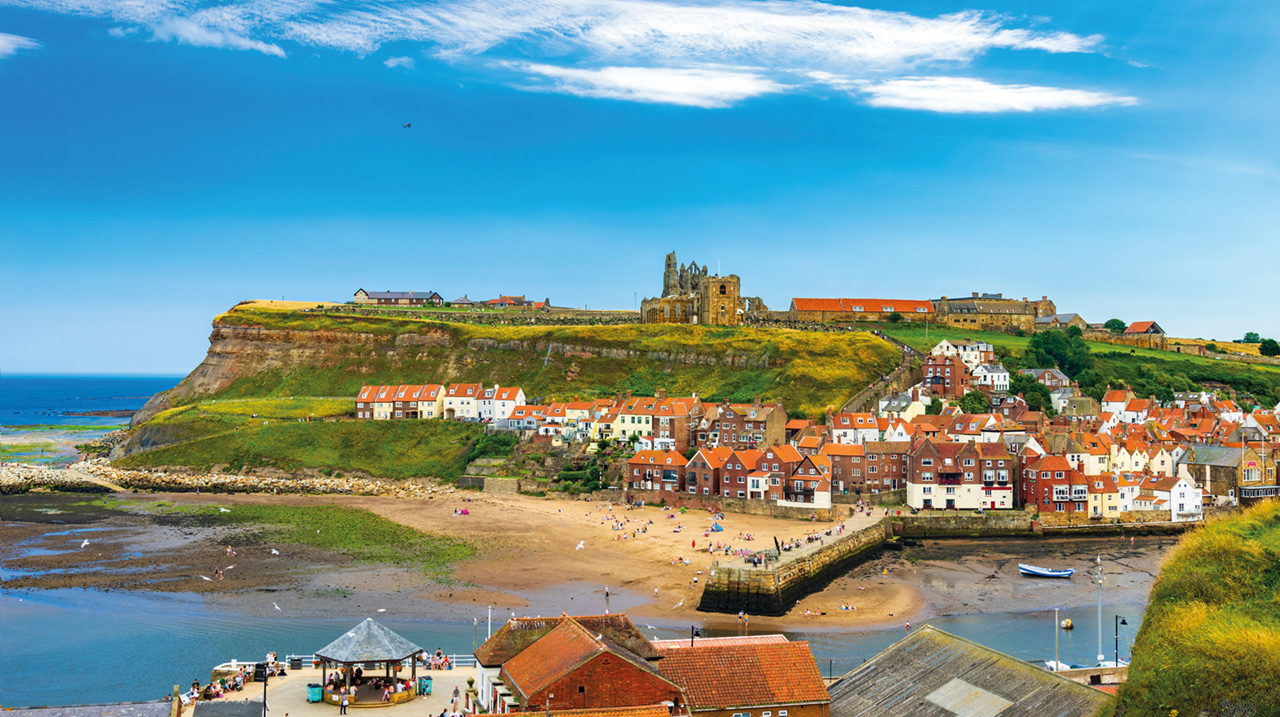Tide changes on second homes
Visitor numbers to Whitby ebb and flow like the sea but a lack of affordable housing remains a constant. Taxing second home owners could be a radical solution
Much like our summer togs, thoughts of venturing to the seaside are often cast aside when the temperature drops and days shorten. This can have a detrimental impact on those living and working in coastal towns who rely heavily on tourism, especially towns such as Whitby that have been besieged by second homeowners in recent years.
Back in 2020, the North Yorkshire town, famous for its historic abbey and association with Bram Stoker’s Dracula, topped a list by the property website Rightmove of the most coveted seaside locations for house hunters.
“The second home premium may not be popular with everyone, but that is not the key factor in this decision.”
“The lockdown periods gave buyers a greater desire for areas with more space near the sea or countryside. Though some people were likely to be looking at a second home, we saw many movers relocating as their lifestyles and priorities changed. Whitby was one example of this,” says Rightmove’s property expert Tim Bannister.
Last year it was second in the list of coastal price hotspots with average asking prices jumping 17 per cent in a year, from £217,620 to £254,218. This is behind only Padstow, in Cornwall, which rose 20 per cent, from £548,382 to £658,588.
“At the beginning of this year, we saw demand beginning to ease in coastal areas compared with last year, with more homes becoming available to purchase as people returned to cities as restrictions lifted. However, demand still greatly outweighs supply in coastal areas and asking prices are still well above where they were before the pandemic,” notes Bannister.
In response to the situation, Whitby made headlines in June when residents voted to ban new builds becoming second homes. Scarborough Borough Council has clarified it was a non-binding vote and there is no ban.
“It was a parish poll that wasn’t binding on any organisation, but it was an expression of local opinion,” notes a council spokesperson.
Those who voted in favour of the ban say locals can no longer afford to buy in the town. The affordable housing crisis is having a knock-on effect on the recruitment and retention of staff for businesses.
It is estimated double the number of affordable properties currently being built across the borough are needed between now and 2038 if demand is to be met.
“We have a project called Better Homes and are in the process of setting up a joint venture to build more affordable homes across the borough,” said the council spokesperson. But it remains to be seen how this might be affected by local government changes.
Scarborough Borough Council is the lead authority on housing for Whitby, but in April, North Yorkshire County Council, Scarborough Borough Council and the other district and borough councils in North Yorkshire are to be replaced by a unitary authority, North Yorkshire Council.
One of the considerations being given to this new local authority is the introduction of a council tax premium for second homeowners.
In September, a landmark decision was made by North Yorkshire County Council’s senior councillors to see a 100 per cent premium introduced for council tax bills on second homes within the next two years.
The proposals, which would effectively double council tax bills for second homeowners, were passed at a full council meeting last week.
That means North Yorkshire is one of the first areas in the country to adopt the government’s new measures, announced in May as part of the Levelling Up and Regeneration Bill, which is currently going through Parliament.
Although the premium will not come into effect until 1 April 2024, it is expected to bring in more than £14 million a year in additional revenue to finance key council priorities, such as introducing more housing in areas particularly affected by the affordability crisis.
The Scarborough district could bring in almost half of that figure due to the large number of second homes in coastal towns such as Whitby, Scarborough and Filey.
“There is no simple solution to the issue of affordable housing, second homes and the impact they have on housing for local communities. But we recognise that bold and decisive action needs to be taken to deal with the affordable housing crisis in North Yorkshire, and that is why the executive has decided to pursue the policy of a council tax premium,” said county council leader Carl Les this autumn.
“It may not be popular with everyone, but that is not the key factor in this decision. We need to act to try and ensure more local people have access to housing in their own communities, and the premium on council tax bills for second homes will be a significant step towards achieving that.”
In the meantime, life carries on, albeit quieter following the summertime madness.

“To be fair, I quite enjoy the quiet of winter in Whitby,” says Fiona Duncan, manager of the independent Whitby Bookshop, on Church Street. “It gives us all a chance to catch our breath, re-charge and appreciate our town without the crowds.
“But the quieter winter months after Christmas can be tough on retailers, especially the seasonal ones. I’d like to see fair rents for local independent business, affordable housing for those that live, work and contribute to the fabric of the town, as well as a limit on second home purchases.
“There is no doubt second homeowners are spending money in the town and supporting our independent shops, but the demand for second homes has pushed the prices of houses and flats way out of the reach of a lot of young people and families. Many retail and hospitality jobs in Whitby pay the national minimum wage. It is nowhere near enough to be able to afford to buy a property here, let alone the rental stock.”
Duncan has worked in the shop for 22 years, having relocated from London in 2000 with her partner, who is from the area.
“There is definitely a buzz about Whitby. Weekend events such as the bi-annual Goth Weekend, Musicport, Whitby Folk Week and the Fish and Ships Festival keep the town vibrant and welcome different audiences. Although great for businesses in Whitby, it can also be a strain on the infrastructure of this small town. Parking is always an issue and just the sheer numbers of people.”
One of the town’s biggest draws is Whitby Abbey – and the 199 steps that lead up to it. Referenced in Bram Stoker’s Dracula, which was published 125 years ago, the abbey welcomed in the region of 130,000 visitors last year.
The famous landmark remains open throughout winter, when the colder months lend a literal chill to the town’s Gothic associations, but there is also a push from the Yorkshire Coast Business Improvement District to show there is plenty to do in the area throughout the year.
“Whitby is a very vibrant town with some incredible businesses catering to all types of people and needs. We have placed a focus on supporting events such as the Whitby Krampus Run, the Whitby Ice Rink and Winter Fest. These events allow us to help drive footfall at a quieter time of the year, ensuring businesses have a continual steam of customers and patrons,” says Clive Rowe-Evans, chair of the Yorkshire Coast BID, which was created to promote towns Whitby, Bridlington and Hornsea, and the villages in between.
“Being an attractive and much-loved town means that at times Whitby can attract a very high footfall during peak season, but face a lull during the quieter months. This can place a strain on businesses that are dependent on footfall all year round,” adds Rowe-Evans.
To combat this, the BID is focusing on investing in projects that are less event oriented.
“One of the projects in Robin Hood’s Bay for example was funding a new defibrillator in an area that didn’t have it, to ensure it is as safe and accessible as possible. In Bridlington, we have been working on a security scheme that helps connect businesses to the police for efficient crime reporting, bringing attention to crime in more rural areas,” he says.
“We want the Yorkshire coast to be a destination that attracts people both long term and for short visits, and the key to this is ensuring it’s an accessible destination with all of the relevant and needed infrastructure in place.”
But there is a careful balance to be managed in order to attract inward investment while retaining the sense of community.
“We hope the charm and uniqueness of Whitby is retained for future generations,” says Rowe-Evans. “The key to our mission is driving awareness of these brilliant destinations not only during the peak summer season, but also highlighting the beautiful locations you can visit during the quieter autumnal and winter months when you get to experience a totally different atmosphere.”

“Whitby is a fascinating place that has been shaped by dramatic eras dominated by religion, seafaring and then tourism,” says Colin Wilkinson, author of Whitby Between the Wars, Whitby in 50 Buildings and Whitby: A Potted History.
“Signs of its religious heritage can still be seen with the abbey and the church on the headland. And then there are the grand houses built for merchants and ship owners when Whitby was a major seaport and shipbuilding centre during the 18th century. It was an era that produced the whaling fleet, and the explorer Captain Cook,” he says.
“The 19th century brought the railway and with it the opportunity to a develop a holiday resort. George Hudson, who became known as the Railway King, played an important part in this until his corrupt business practices were exposed. He helped to bring about the development of the town’s West Cliff with the Royal Hotel and the streets of substantial Victorian terraces providing lodgings, as they still do, for visitors.”
It was during this period Whitby became a fashionable resort attracting the likes of Charles Dickens, Elizabeth Gaskell and Bram Stoker. It further flourished as a resort in the 20th century during the inter-war years.
“New facilities were developed, but fortunately the development was limited and low key and the charm of the place retained. As one journal reported in early 20th century: ‘You must go in the spirit of the artist in searching for the picturesque, the quaint and the historic or you will be disappointed. To those who want the endless round of gaiety of Scarborough, Blackpool or the Isle of Man, Whitby will be dull and profitless.’
“It is still relatively isolated as three of the four rail links were axed in the 1950s and 1960s and there is no motorway or dual carriageway across the winding moors roads, and yet this has not impacted its popularity,” says Wilkinson.
“But what I have wanted to do through my books is show there is more to this fascinating town than a walk along the harbour side to the beach, fish and chips and a climb up the 199 steps to the abbey ruins.”

Leave a reply
Your email address will not be published.